brake pads FIAT PUNTO 2020 Owner handbook (in English)
[x] Cancel search | Manufacturer: FIAT, Model Year: 2020, Model line: PUNTO, Model: FIAT PUNTO 2020Pages: 219, PDF Size: 9.82 MB
Page 4 of 219
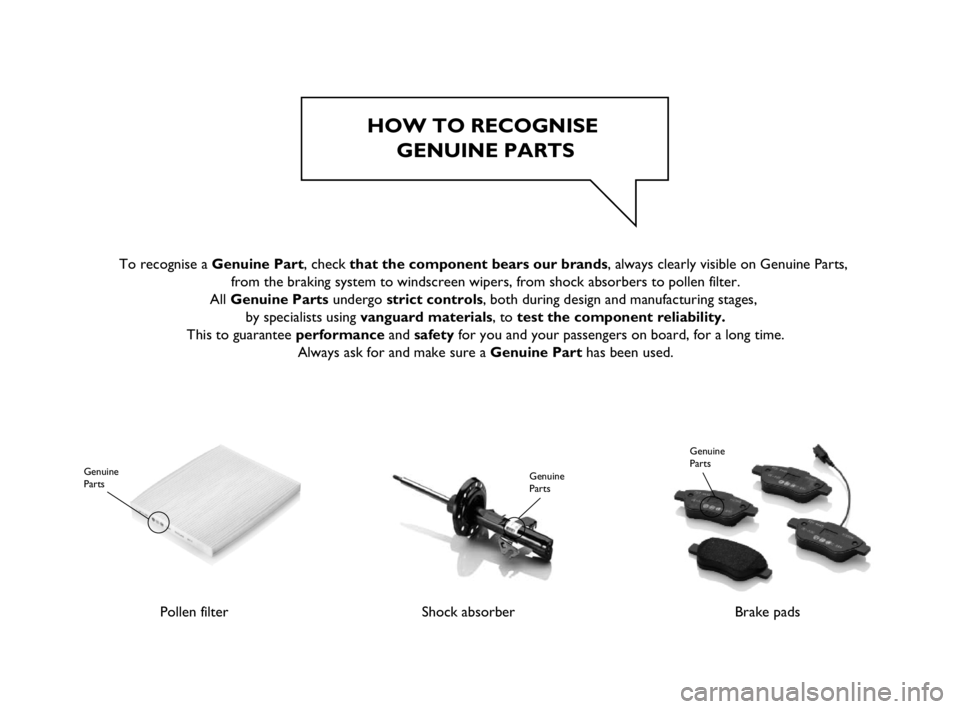
HOW TO RECOGNISE GENUINE PARTS
Pollen filter
Genuine
Parts
Shock absorber
Genuine
Parts
Brake pads
Genuine
Parts
To recognise a Genuine Part, check that the component bears our brands, always clearly visible on Genuine Parts, from the braking system to windscreen wipers, from shock absorbers to po\
llen filter.
All Genuine Parts undergo strict controls, both during design and manufacturing stages, by specialists using vanguard materials, to test the component reliability.
This to guarantee performance and safety for you and your passengers on board, for a long time. Always ask for and make sure a Genuine Part has been used.
001-032 PUNTO POP 1ed EN 31/03/14 09:02 Pagina II
Page 76 of 219
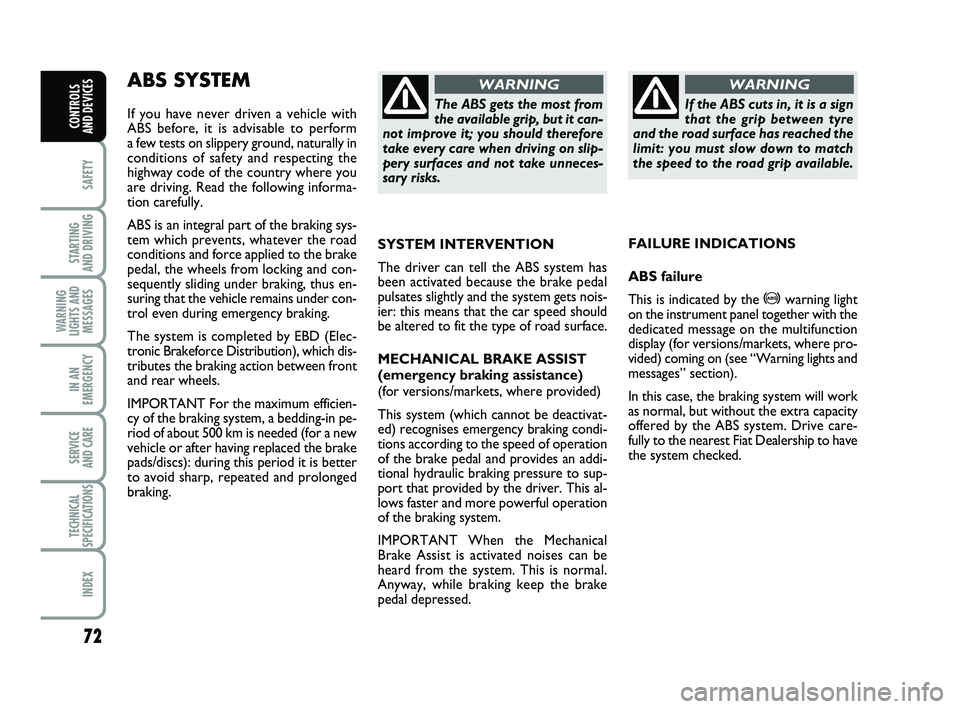
72
SAFETY
STARTING
AND DRIVING
WARNING
LIGHTS AND MESSAGES
IN AN
EMERGENCY
SERVICE
AND CARE
TECHNICAL
SPECIFICATIONS
INDEX
CONTROLS
AND DEVICES
ABS SYSTEM
If you have never driven a vehicle with
ABS before, it is advisable to perform
a few tests on slippery ground, naturally in
conditions of safety and respecting the
highway code of the country where you
are driving. Read the following informa-
tion carefully.
ABS is an integral part of the braking sys-
tem which prevents, whatever the road
conditions and force applied to the brake
pedal, the wheels from locking and con-
sequently sliding under braking, thus en-
suring that the vehicle remains under con-
trol even during emergency braking.
The system is completed by EBD (Elec-
tronic Brakeforce Distribution), which dis-
tributes the braking action between front
and rear wheels.
IMPORTANT For the maximum efficien-
cy of the braking system, a bedding-in pe-
riod of about 500 km is needed (for a new
vehicle or after having replaced the brake
pads/discs): during this period it is better
to avoid sharp, repeated and prolonged
braking.The ABS gets the most from
the available grip, but it can-
not improve it; you should therefore
take every care when driving on slip-
pery surfaces and not take unneces-
sary risks.
WARNING
SYSTEM INTERVENTION
The driver can tell the ABS system has
been activated because the brake pedal
pulsates slightly and the system gets nois-
ier: this means that the car speed should
be altered to fit the type of road surface.
MECHANICAL BRAKE ASSIST
(emergency braking assistance)
(for versions/markets, where provided)
This system (which cannot be deactivat-
ed) recognises emergency braking condi-
tions according to the speed of operation
of the brake pedal and provides an addi-
tional hydraulic braking pressure to sup-
port that provided by the driver. This al-
lows faster and more powerful operation
of the braking system.
IMPORTANT When the Mechanical
Brake Assist is activated noises can be
heard from the system. This is normal.
Anyway, while braking keep the brake
pedal depressed.
If the ABS cuts in, it is a sign
that the grip between tyre
and the road surface has reached the
limit: you must slow down to match
the speed to the road grip available.
WARNING
FAILURE INDICATIONS
ABS failure
This is indicated by the
>warning light
on the instrument panel together with the
dedicated message on the multifunction
display (for versions/markets, where pro-
vided) coming on (see “Warning lights and
messages” section).
In this case, the braking system will work
as normal, but without the extra capacity
offered by the ABS system. Drive care-
fully to the nearest Fiat Dealership to have
the system checked.
070-090 PUNTO POP 1ed EN 24/03/14 11:36 Pagina 72
Page 125 of 219
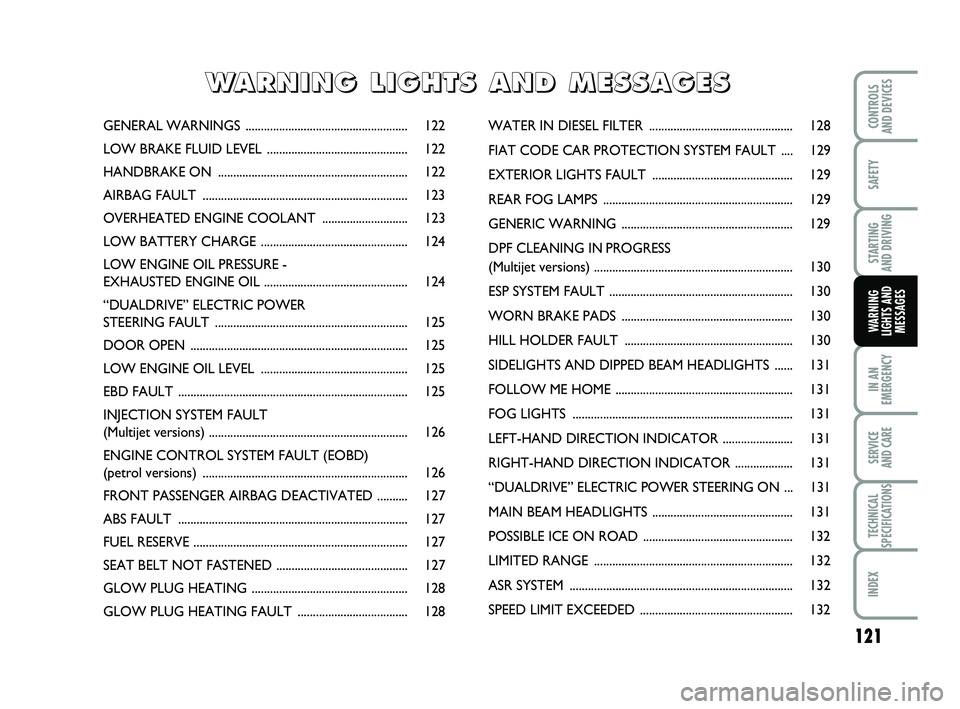
121
SAFETY
STARTING
AND DRIVING
IN AN
EMERGENCY
SERVICE
AND CARE
TECHNICAL
SPECIFICATIONS
INDEX
CONTROLS
AND DEVICES
WARNING
LIGHTS AND MESSAGES
GENERAL WARNINGS ..................................................... 122
LOW BRAKE FLUID LEVEL .............................................. 122
HANDBRAKE ON .............................................................. 122
AIRBAG FAULT ................................................................... 123
OVERHEATED ENGINE COOLANT ............................ 123
LOW BATTERY CHARGE ................................................ 124
LOW ENGINE OIL PRESSURE -
EXHAUSTED ENGINE OIL ............................................... 124
“DUALDRIVE” ELECTRIC POWER
STEERING FAU LT ............................................................... 125
DOOR OPEN .......................................................................\
125
LOW ENGINE OIL LEVEL ................................................ 125
EBD FAULT .......................................................................\
.... 125
INJECTION SYSTEM FAULT
(Multijet vers ions) ................................................................. 126
ENGINE CONTROL SYSTEM FAULT (EOBD)
(petrol vers ions) ................................................................... 126
FRONT PASSENGER AIR BAG DEACTIVATED .......... 127
ABS FAULT .......................................................................\
.... 127
FUEL RESERVE ...................................................................... 127
SEAT BELT NOT FASTENED ........................................... 127
GLOW PLUG H EATING ................................................... 128
GLOW PLUG HEATIN G FAULT .................................... 128 WATER IN DIES
EL FILTER ............................................... 128
FIAT CODE CAR PROTECTION SYSTEM FAULT .... 129
EXTERIOR LIG HTS FAULT .............................................. 129
REAR FOG LAMPS .............................................................. 129
GENERIC WAR NING ........................................................ 129
DPF CLEANING IN PROGRESS
(Multijet versions) ................................................................. 130
ESP SYSTEM FAU LT ............................................................ 130
WORN BRAKE PADS ........................................................ 130
HILL HOLDER FAULT ....................................................... 130
SIDELIGHTS AND DIPP ED BEAM HEADLIGHTS ...... 131
FOLLOW ME HO ME .......................................................... 131
FOG LIGHTS ........................................................................\
131
LEFT-HAND DIRECTION INDICAT OR ....................... 131
RIGHT-HAND DIRECT ION INDICATOR ................... 131
“DUALDRIVE” ELECTRIC POWER STEERING ON ... 131
MAIN BEAM HEADLIGHTS .............................................. 131
POSSIBLE ICE ON ROAD .................................................
132
LIMITED RANGE ................................................................. 132
ASR SYSTEM ......................................................................\
... 132
SPEED LIMIT EXCEEDED .................................................. 132
W
W
A
A
R
R
N
N
I
I
N
N
G
G
L
L
I
I
G
G
H
H
T
T
S
S
A
A
N
N
D
D
M
M
E
E
S
S
S
S
A
A
G
G
E
E
S
S
121-132 PUNTO POP 1ed EN 29/08/13 15.03 Pagina 121
Page 134 of 219
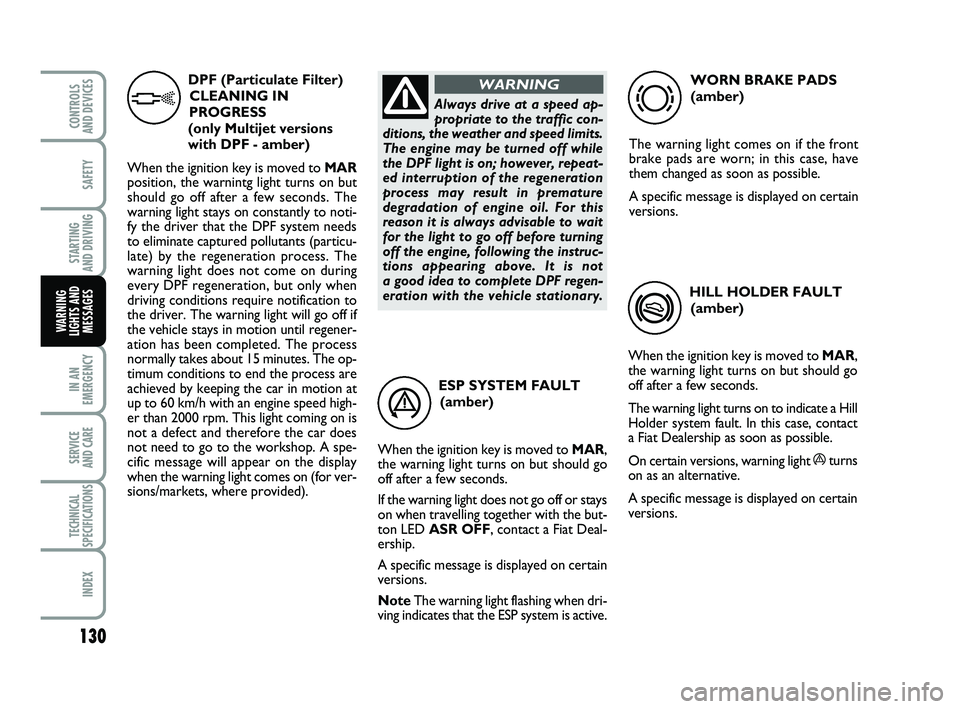
130
SAFETY
STARTING
AND DRIVING
IN AN
EMERGENCY
SERVICE
AND CARE
TECHNICAL
SPECIFICATIONS
INDEX
CONTROLS
AND DEVICES
WARNING
LIGHTS AND MESSAGES
ESP SYSTEM FAULT
(amber)
When the ignition key is moved to MAR,
the warning light turns on but should go
off after a few seconds.
If the warning light does not go off or stays
on when travelling together with the but-
ton LED ASR OFF, contact a Fiat Deal-
ership.
A specific message is displayed on certain
versions.
Note The warning light flashing when dri-
ving indicates that the ESP system is active.
á
HILL HOLDER FAULT
(amber)
When the ignition key is moved to MAR,
the warning light turns on but should go
off after a few seconds.
The warning light turns on to indicate a Hill
Holder system fault. In this case, contact
a Fiat Dealership as soon as possible.
On certain versions, warning light
áturns
on as an alternative.
A specific message is displayed on certain
versions.
*
WORN BRAKE PADS
(amber)
The warning light comes on if the front
brake pads are worn; in this case, have
them changed as soon as possible.
A specific message is displayed on certain
versions.
d
DPF (Particulate Filter) CLEANING IN
PROGRESS
(only Multijet versions
with DPF - amber)
When the ignition key is moved to MAR
position, the warnintg light turns on but
should go off after a few seconds. The
warning light stays on constantly to noti-
fy the driver that the DPF system needs
to eliminate captured pollutants (particu-
late) by the regeneration process. The
warning light does not come on during
every DPF regeneration, but only when
driving conditions require notification to
the driver. The warning light will go off if
the vehicle stays in motion until regener-
ation has been completed. The process
normally takes about 15 minutes. The op-
timum conditions to end the process are
achieved by keeping the car in motion at
up to 60 km/h with an engine speed high-
er than 2000 rpm. This light coming on is
not a defect and therefore the car does
not need to go to the workshop. A spe-
cific message will appear on the display
when the warning light comes on (for ver-
sions/markets, where provided).
hAlways drive at a speed ap-
propriate to the traffic con-
ditions, the weather and speed limits.
The engine may be turned off while
the DPF light is on; however, repeat-
ed interruption of the regeneration
process may result in premature
degradation of engine oil. For this
reason it is always advisable to wait
for the light to go off before turning
off the engine, following the instruc-
tions appearing above. It is not
a good idea to complete DPF regen-
eration with the vehicle stationary.
WARNING
121-132 PUNTO POP 1ed EN 29/08/13 15.03 Pagina 130
Page 171 of 219
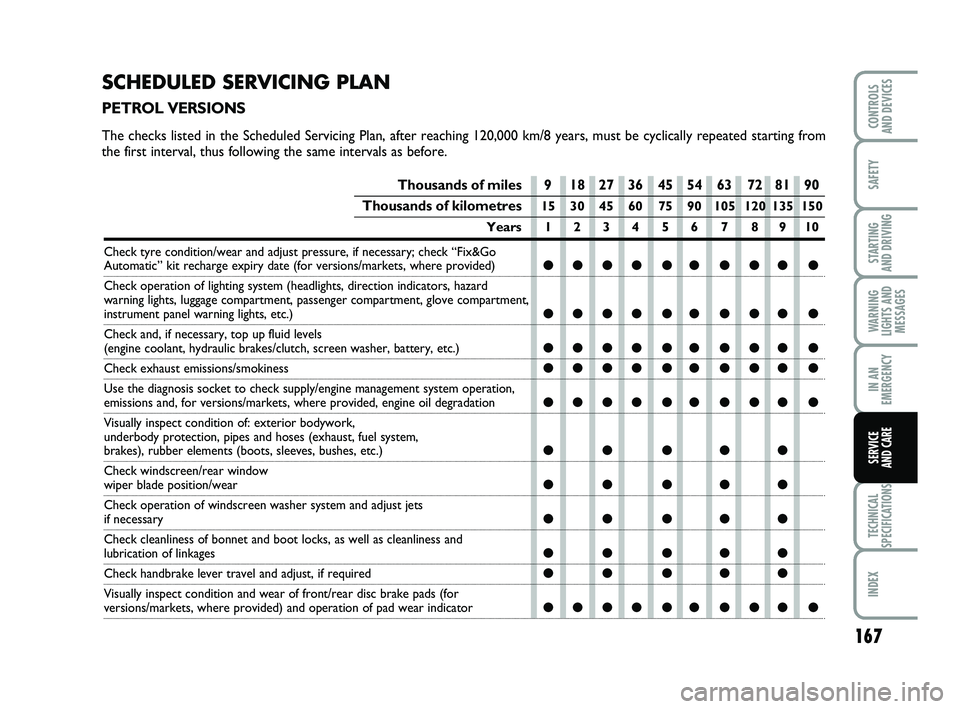
167
SAFETY
STARTING
AND DRIVING
WARNING
LIGHTS AND MESSAGES
IN AN
EMERGENCY
TECHNICAL
SPECIFICATIONS
INDEX
CONTROLS
AND DEVICES
SERVICE
AND CARE
Thousands of miles 9 18 27 36 45 54 63 72 81 90
Thousands of kilometres15 30 45 60 75 90 105 120 135 150
Years 1234 56 7 8910
Check tyre condition/wear and adjust pressure, if necessary; check “F\
ix&Go Automatic” kit recharge expiry date (for versions/markets, where pro\
vided)●●●● ●● ●●● ●
Check operation of lighting system (headlights, direction indicators, h\
azard
warning lights, luggage compartment, passenger compartment, glove compar\
tment,
instrument panel warning lights, etc.)●●●● ●● ●●● ●
Check and, if necessary, top up fluid levels (engine coolant, hydraulic brakes/clutch, screen washer, battery, etc.)\
●●●● ●● ●●● ●
Check exhaust emissions/smokiness●●●● ●● ●●● ●
Use the diagnosis socket to check supply/engine management system operat\
ion, emissions and, for versions/markets, where provided, engine oil degradat\
ion●●●● ●● ●●● ●
Visually inspect condition of: exterior bodywork,
underbody protection, pipes and hoses (exhaust, fuel system,
brakes), rubber elements (boots, sleeves, bushes, etc.)●● ●●●
Check windscreen/rear window wiper blade position/wear●● ●●●
Check operation of windscreen washer system and adjust jets if necessary●● ●●●
Check cleanliness of bonnet and boot locks, as well as cleanliness and lubrication of linkages●● ●●●
Check handbrake lever travel and adjust, if required●● ●●●
Visually inspect condition and wear of front/rear disc brake pads (for \
versions/markets, where provided) and operation of pad wear indicator●●●● ●● ●●● ●
SCHEDULED SERVICING PLAN
PETROL VERSIONS
The checks listed in the Scheduled Servicing Plan, after reaching 120,00\
0 km/8 years, must be cyclically repeated starting from
the first interval, thus following the same intervals as before.
165-184 PUNTO POP 1ed EN 07/04/14 09:35 Pagina 167
Page 174 of 219
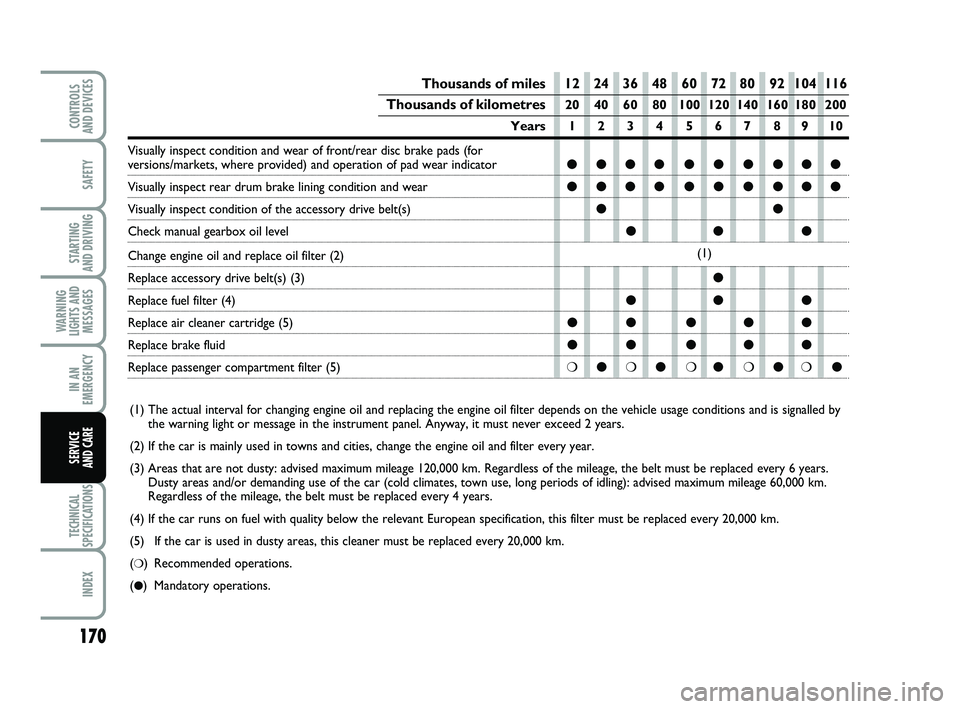
170
SAFETY
STARTING
AND DRIVING
WARNING
LIGHTS AND MESSAGES
IN AN
EMERGENCY
TECHNICAL
SPECIFICATIONS
INDEX
CONTROLS
AND DEVICES
SERVICE
AND CARE
Thousands of miles 12 24 36 48 60 72 80 92 104 116
Thousands of kilometres20 40 60 80 100 120 140 160 180 200
Years 1234 567 8910
Visually inspect condition and wear of front/rear disc brake pads (for \
versions/markets, where provided) and operation of pad wear indicator●●●● ●● ●●●●
Visually inspect rear drum brake lining condition and wear●●●● ●● ●●●●
Visually inspect condition of the accessory drive belt(s)●●
Check manual gearbox oil level●● ●
Change engine oil and replace oil filter (2)
Replace accessory drive belt(s) (3) ●
Replace fuel filter (4)●● ●
Replace air cleaner cartridge (5) ●● ●●●
Replace brake fluid ●● ●●●
Replace passenger compartment filter (5) ❍●❍●❍●❍●❍●
(1) The actual interval for changing engine oil and replacing the engi\
ne oil filter depends on the vehicle usage conditions and is signalled by
the warning light or message in the instrument panel. Anyway, it must ne\
ver exceed 2 years.
(2) If the car is mainly used in towns and cities, change the engine o\
il and filter every year.
(3) Areas that are not dusty: advised maximum mileage 120,000 km. Rega\
rdless of the mileage, the belt must be replaced every 6 years.
Dusty areas and/or demanding use of the car (cold climates, town use, l\
ong periods of idling): advised maximum mileage 60,000 km.
Regardless of the mileage, the belt must be replaced every 4 years.
(4) If the car runs on fuel with quality below the relevant European s\
pecification, this filter must be replaced every 20,000 k m.
(5) If the car is used in dusty areas, this cleaner must be replaced every 2\
0,000 km.
(
❍) Recommended operations.
(
●) Mandatory operations.
(1)
165-184 PUNTO POP 1ed EN 07/04/14 09:35 Pagina 170